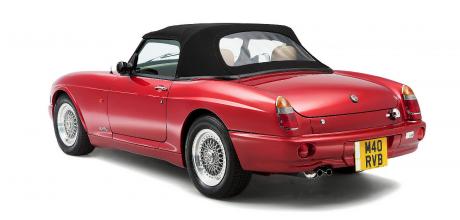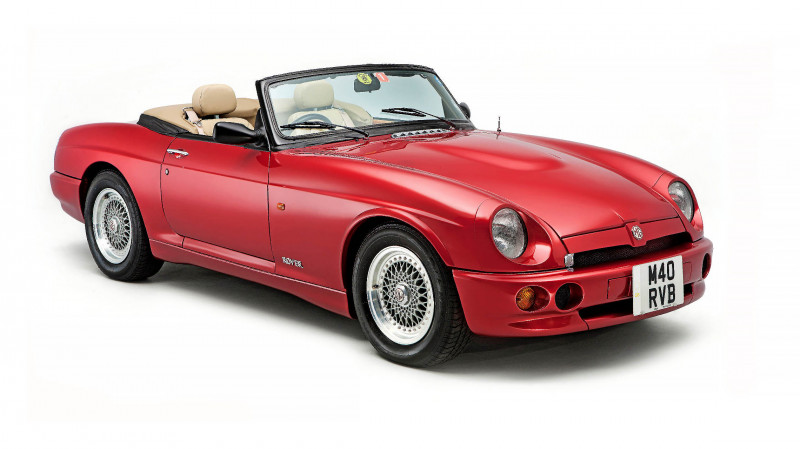Buying Guide MG RV8

Robust, genuinely special and curiously overlooked, MG’s Nineties V8 tourer is ripe for buying
Words JAMES WALSHE
Photography JOHN COLLEY/MAGIC CAR PICS
Six steps to buying a MG RV8
Buying Guide How to buy a fine MG RV8 without fear
MG’s RV8 is an unusual beast, with unrealised market potential. It exists for unusual reasons that only add to its appeal – created to test the market and gauge emotional responses to the MG badge, which at the time of the RV8’s 1992 introduction had been worn by hot hatches and saloons for a decade, rather than traditional sports cars. It worked. Although it was expensive and based on old-fashioned technology, the market’s response to the RV8 persuaded the Rover Group to create a cheaper, smaller, more mass-market sports car – the MGF.

‘Under-use and long layups are common’
Although the RV8 was criticised in period by the motoring press for not being particularly sporty, especially when compared to the similarly-priced TVR Chimaera with which it shared an engine, it has a more rarified appeal. Think of it as the baby B-based Aston Martin that MG looked into building in the early Eighties, a handbuilt and exclusive V8-powered grand tourer trimmed with leather and walnut. With this in mind, the fact you can get one for less than £10k – for now – makes it something of a bargain.
Which one to choose?
- With such a short production life – 1992-1995 – picking an MG RV8 is more a question of specification rather than era.
- Fundamentally, it’s a thoroughly re-engineered MGB with a 3.9-litre Range Rover V8, a British Motor Heritage-derived bodyshell reworked with wider wheelarches, larger rear light clusters, smoother bumpers, sleeker frontal aerodynamics and a reprofiled windscreen. Inside, all were trimmed with wood and leather in the manner of a Range Rover HSE.
- The majority of the 2000 examples built were exported, especially to Japan. A Japanese-market car can be identified – aside from its service history – by the standard-fit air-conditioning unit, which protrudes into the passenger-side footwell, and fitment for an emergency breakdown distress flare, which the Japanese use in lieu of a warning triangle. These Japanese-market examples tend to have racked up fewer miles and are less likely to exhibit surface corrosion.
- Only two changes were made during the MG RV8’s production life. From chassis 644, in 1994, the gearbox gate was reworked, moving reverse gear from the top left of the gate to the bottom right. And from chassis 1225, in 1995, the exterior styling was mildly revised, removing the prominent lip extensions from the front wheelarches.
Engine
The 3.9-litre Rover V8 is a known quantity, given that it was the go-to power unit for the British specialist industry for two decades. Unsurprisingly it’s a reliable power unit, and won’t cause much trouble in service, but don’t assume it’s bulletproof. The camshaft can be weak, and you’ll pick up any issues on a test drive by listening for gentle top-end tapping and misfires when driving. Being aluminium, the state of its cooling system is paramount, so make sure it runs up to temperature and stays there, and the radiator is in good condition. Low mileage examples aren’t hard to find, but on cars like this, you need to ensure they’ve been serviced according to time intervals, as opposed to mileage, along with annual rather than factory-advised 5000-mile oil changes. Finally, check the condition of the exhaust manifolds – replacement of all four is time consuming. Replacement manifolds cost £840 per pair, are unique to the RV8, and are often out of stock.

Parts availability for the ubiquitous Rover V8 isn’t as plentiful as it once was, especially for the 3.9-litre unit the RV8 uses. If an engine is neglected and beyond full rebuild – a £6000 job when undertaken professionally – bear in mind that a replacement unit will set you back £7500 exclusive of fitting costs. TVR and Range Rover specialists are more used to dealing with this variant than traditional MG outlets.
Bodywork & structure
It might be a cruiser, but the RV8 is also decently quick and a fair few over the years have been crashed. Look carefully for accident damage – poorly repaired areas should be easy to spot thanks to tell-tale corrosion. Although the bodyshell and panels are readily available, they can also be expensive – such as front wings at £1100-£1300.
Unlike the original MGB, upon which it is so closely based, the RV8’s body won’t rust in any significant way. Its Heritage bodyshell was electrophoretically dipped after the metal had already been zinc-coated, and even today, obvious corrosion is rare. But any welding repairs require the zinc coating to be ground off, compromising the rust protection. Pay close attention to the windscreen surround which, thanks to its steel box-section construction, is a water trap. Repair is possible but replacement is more desirable. Part-composite replacements, specially designed to avoid rust, cost £975, although replacement is relatively straightforward. There are even step-by- step guides available online.
Overall, shabby or rotten RV8s are virtually unheard of. They’re more likely to be accident damaged so get stuck into the paperwork and bring some overalls so you can inspect the car carefully underneath. The mechanicals are of archaic design, but with more electrics than a ‘B and more trim.
Interior
Build quality was generally good, although some of the shared interior switchgear (sourced from the Austin Metro and Maestro, and Rover’s 200 and 800 series) can be unreliable. However replacement for these shared components is easy and availability is good thanks to XPart’s vast store of spares from the old Austin Rover Group empire. Leather and wood is straightforward to fix, but expensive to do to the original’s high quality – you might be better off sourcing new seats for £500 than repairing badly-damaged leather. The hood is also good but can develop leaks with age. Replacements cost from £700 for aftermarket vinyl, to £1300 for a fully-fitted bespoke replacement in original-style fabric. Japanese market cars came with air con as standard; it was an option in the UK. It’s a reliable system, and easily maintained, although check the service history to ensure it’s been converted to R134 standards. It needs to be recharged every three years in order to give its best.
Recommissioning
Thanks to their second-car nature and collector appeal since new, under-use and long layups are common with RV8s, leading to seized brakes and perished hoses, tyres and gaskets. Be prepared to spend up to £2000 getting a garage-stored car roadworthy, otherwise driving it could damage it and generate much bigger bills in the future.
Rover V8 a known quantity; Range Rover/TVR people know 3.9 best Interior is genuinely high-quality; leather and wood replacement is costly.
What to pay
- Good, usable cars start at £9500. A regularly-used, well-maintained example might actually be easier to live with than a mint low-miler out of storage though – the sort of thing you’ll pay £11,500 for. Beautifully maintained Japanese imports fetch £17,500, and some excellent restored cars have been known to make £20,000-£24,000.
- The other main influence on price is colour. With 80 percent of the production run finished in green, there is a premium placed on red, blue, black, white and gold. For this reason, check the car’s maintenance history and other evidence of a colour change.
Owning an MG RV8
Lee Rose
‘I was a regular on the MG club circuit, often admiring RV8s,’ says Lee Rose. ‘Then one day, a former colleague called to say that her stepfather, John Bolt, had passed away. She and her mum weren’t sure what to do with his car so I took it for a test drive and the rest is history! I feel honoured to be carrying on John’s work to preserve such a stunning, well-maintained example. It’s a straightforward car to look after and live with, although it pays to know its history, and how it’s been treated and used.
‘John was a historian for the MG Car Club’s V8 Register, so the car’s history has been researched extensively. The car was – like most RV8s – exported to Japan in 1994. It came back just three years later, which is when John snapped it up. I was told that he actually went to the launch back in 1992, with the intention of putting down a deposit. However, he walked away when he saw the asking price – a crazy-for-the- time £26,000!
‘It’s a hand-built British sports car and such a different animal to most. It’s luxurious inside with all the wood and Connolly leather, it’s fast, the torque is sensational and it’s rare in this colour – only 152 were made in Nightfire Red. The RV8 is a car with a great development story, too.
‘I also have an MGF, which I’ve sadly been neglecting because of the RV8’s many virtues. The RV8 is the car I take on holiday to France – it’s a great grand tourer.’
Sponsored by Carole Nash Insurance
Peter McIlvenny of specialist classic car insurer Carole Nash says, ‘With only around 600 in the UK the MGRV8 is certainly a niche offering and a real head turner. If you are looking at a Japanese re-import don’t be put off by a shortage of service history; just ensure you get it professionally assessed and that you get all those service jobs done and documented. In terms of values over the next ten years, prices may be affected by high fuel prices with people turning to the lower running costs of a standard B for example. But don’t let that put you off, these are great classics with plenty of grunt. Just don’t expect one to pay for your retirement.
Classic car insurance quotes: 0333 005 7541 or carolenash.com
1994 MG RV8 – £23,000
With improved R380 gearbox, air con. 30,549 genuine mileage. Has the best Burr Elm Wood I’ve seen on this model. High efficiency radiator. Full tonneau cover and wind deflector. Matching RV8 mats. Spax dampers. Beautiful condition throughout, including hood. Many new parts. Kenwood sound system with Bluetooth. Lots of paperwork and receipts. Two keys. Handbook, parts manual and repair manual. MoT’d till March 2023.

